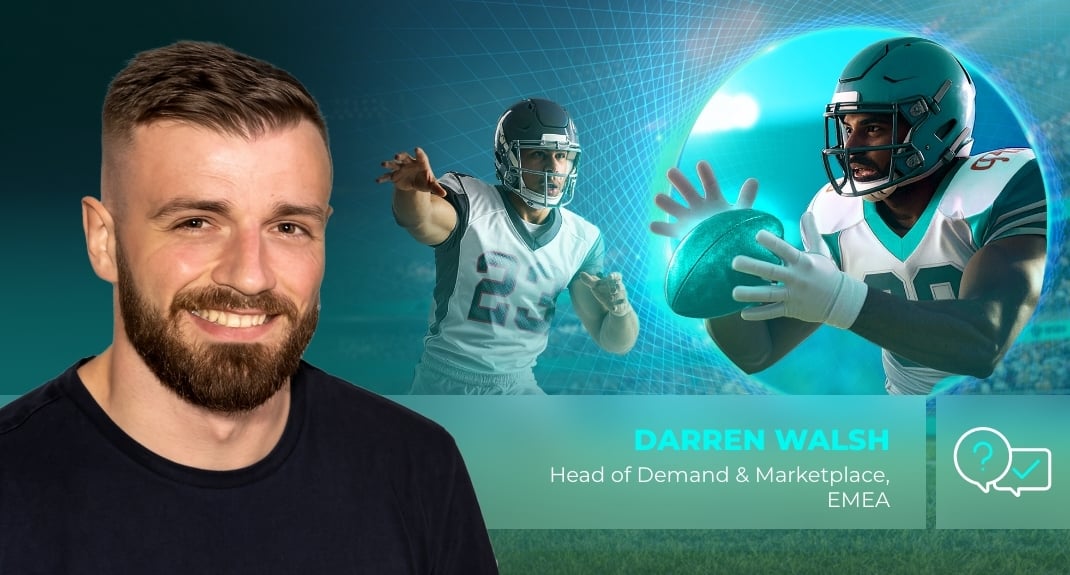- Newsroom
- >
- Forget the Sidelines: Why Your Sports Budget Belongs In-Game

Forget the Sidelines: Why Your Sports Budget Belongs In-Game
As Head of Demand and marketplace for EMEA at Anzu, I spend my days talking to brands and agencies about where to place their advertising bets. After a whirlwind of conversations at CES and Cannes Lions, conversations with our agency and tech partners were clear: sports is on everyone's minds, and the worlds of sports and gaming are colliding in a big way.
This isn’t just a professional observation; as a lifelong sports fan and gamer, I see this convergence not just in market data, but in my own living room. The lines are blurring completely, with figures like Jake Paul and KSI entering the Boxing Ring or Max Verstappen, who has his own esports racing team, bridging the gap between digital entertainment and traditional sports.
Advertisers see the massive opportunity presented by a calendar packed with global sporting events, but they’re also asking the tough questions about how to measure the impact of their investments.
The Media Planning Problem: Bridging Two Worlds
From my conversations, a recurring theme emerges: brands and agencies are wrestling with how to bridge the gap between their sports and gaming activations. Too often, these are treated as separate budgets and strategies, which ignores how modern audiences consume content. As we look toward the 2026 World Cup, which will be a pivotal moment for the ad industry in the coming year, the demand for a true omnichannel playbook that integrates streaming, social, and gaming is at an all-time high.
Advertisers face a dual challenge. First, the cost of entry for major event sponsorships is prohibitive for many. With brands like Rolex and Evian owning Wimbledon, Heineken, Masterсard, and Pepsi owning the Champions League, and Red Bull, Mercedes, and Petronas owning the F1, it makes it nearly impossible for competitors to break through.
Second, global economic pressures and budget constraints are forcing every dollar to work harder. In a stadium, you might reach thousands, but you have little idea who that user is or if they are in the market for your product or service. This is where gaming offers a powerful solution. For example, we know that people who play golf games are mostly males aged 45-64 with an average household income over $100K+ and are interested in electronics, books, and dining out. Whereas, those who play motorsports titles are predominantly 18-34 males with an average household income of $40K-$60, and are more interested in music, food, and beverages.
Gaming’s Opportunity: Better, Not Just Bigger
Gaming provides an accessible entry point for brands to engage with major sports moments, and the opportunity isn’t just about a lower cost; it’s about a smarter, more precise way to reach fans.
Intrinsic in-game advertising offers unique advantages.
At Anzu, we can move beyond passion and apply precision, using first-party data to target audiences just like you can on any other digital ad channel. This also creates a powerful opportunity for “conquesting.” If a legacy brand owns the sponsorship for a real-world tournament, gaming allows a competitor to come in, target that same fan base within a tennis or F1 title, and own that moment in the virtual space.
Creative agility is another key factor. During a live broadcast, pitch-side advertising is static. In a gaming environment, a brand can test multiple creatives and measure what resonates. A well-known fashion brand client we work with masterfully uses gaming for both large-scale sponsorships and programmatic campaigns to reach diverse audiences across sports, fashion, and lifestyle, measuring the real-world impact of their creative.
Crucially, this approach adds to the experience. As a gamer, when I see ads in a game like UFL or Trackmania change in real-time to match my interests, it’s a talking point. It brings a real-world element to my gameplay that I’ll show to my friends, which is far more impactful than a disruptive ad.
The Missed Opportunity on the Horizon
Looking back in two or three years, I believe advertisers will regret not investing enough in gaming now. We’re in a period of global economic uncertainty, but history has shown that brands that double down during these moments emerge stronger. I often use the example of Kellogg's, which increased its advertising during the Great Depression and thrived, growing market share by over 30%. We also saw many examples like this during the COVID pandemic.
For me personally, the two things that evoke the highest emotions are sports and gaming. You get the exhilarating highs and the crushing lows. People remember those moments. While a fan may only spend 90 minutes watching a live match, they can easily spend four or five hours playing a sports game, deeply engaged and attentive. By placing non-intrusive, memorable ads within these immersive worlds, brands can create a powerful and lasting connection.
Gaming is no longer a niche tactic; it is table stakes for any brand serious about activating around sport.

Darren is Anzu's Head of Demand & Marketplace EMEA and is based in London.